ICSE Class 10 Biology Chapter 6 Selina Concise Solutions - Free PDF Download
Updated ICSE Class 10 Biology Chapter 6 - Photosynthesis Selina Solutions are provided by Vedantu in a step by step method. Selina is the most famous publisher of ICSE textbooks. Studying these solutions by Selina Concise Biology Class 10 Solutions which are explained and solved by our subject matter experts will help you in preparing for ICSE exams. Concise Biology Class 10 ICSE Solutions can be easily downloaded in the given PDF format. These solutions for Class 10 ICSE will help you to score good marks in ICSE Exams 2024-25.
The updated solutions for Selina textbooks are created in accordance with the latest syllabus. These are provided by Vedantu in a chapter-wise manner to help the students get a thorough knowledge of all the fundamentals.
Access ICSE Selina Solutions for Grade 10 Biology Chapter No. 6 - Photosynthesis
1. Answer the following in “Yes” or “No”
(i). All parts of green plants carry out photosynthesis
Ans: No ,this is because photosynthetic pigment (called chlorophyll) is required to carry out the process of photosynthesis & it is mainly present in the leaves only.
(ii). All green parts of a plant carry out photosynthesis
Ans: Yes ,this is because green parts of the plants are provided with photosynthetic pigment (called chlorophyll) which is one of the most important raw material for the process of photosynthesis.
(iii). Photosynthesis is the only biological process that releases oxygen into the air
Ans: Yes ,this statement is true.
(iv). Out of nine types of chlorophyll , chlorophyll a & b are the most abundant.
Ans: Yes,this statement is true.
(v). Too much light destroys chlorophyll.
Ans: Yes,this is because chlorophyll is sensitive to sunlight and too much sunlight destroys it. However, formation of chlorophyll depends on the exposure of the plant to the light.
(vi). No transpiration occurs during photosynthesis.
Ans: No,this is because the process of transpiration(loss of water in the form of water vapours occurs through the aerial parts of the plants)occurs when the stomata opens for the passage of carbon dioxide.
(vii). During sunlight the guard cells turn flaccid to open the stomata.
Ans: No,this is because during the day time chlorophyll containing guard cells prepare the food (carbohydrate) & become turgid to allow the stomatal pore to open.
Progress check
1. Write the overall summary chemical equation for photosynthesis.
Ans: Photosynthesis is a process by which the autotrophic organisms(green plants) prepare their own food. It requires water, sunlight, chlorophyll & carbon dioxide.The process of photosynthesis is carried out in chloroplast.The summary chemical equation for photosynthesis is given below-:
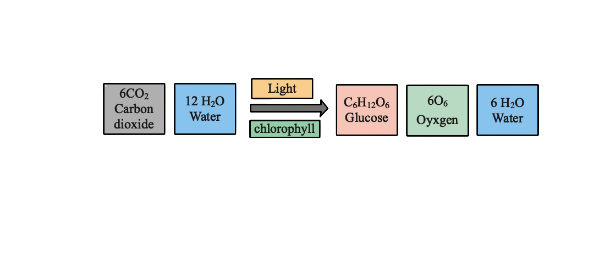
2. Which single substance in the above equation is repeated in raw material as well as reproduced as an end product?
Ans: The substance that is repeated in raw material as well as reproduced as an end product is water.
3. What is the source of oxygen released in photosynthesis - Carbon dioxide or water?
Ans: The source of oxygen released in photosynthesis is water.
Photolysis is the breakdown of water molecules in the presence of sunlight.It is mainly responsible for the liberation of oxygen during the process of photosynthesis.
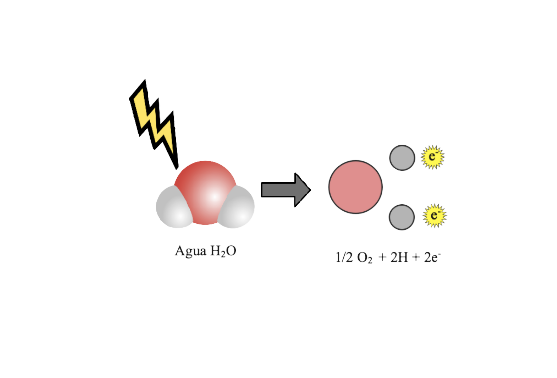
4. Dark reaction involves utilization of carbon dioxide in producing glucose. Why is this phase called dark reaction?
Ans: This is because the reactions that take place during this phase are independent of light.
5. What happens photolysis?
Ans:
Photolysis-:It is defined as the breakdown of water molecules in the presence of sunlight.It is mainly responsible for the liberation of oxygen during the process of photosynthesis.The process of photolysis is given below-:
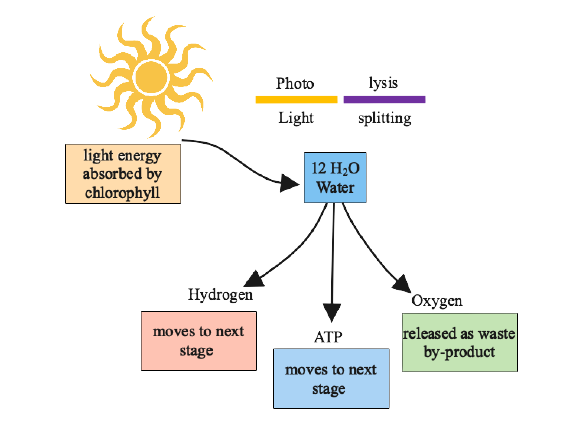
6. Glucose produced during photosynthesis is soon polymerised into starch. What does polymerisation mean?
Ans: It is defined as the process during which monomers join together to form a polymer. Starch is the polymer of glucose units.
7. Why is it better to call the dark phase of photosynthesis as “light independent phase”?
Ans: This is because the chemical reactions during this phase are independent of light.
Progress check
1. How do the following favours increased photosynthesis?
(i) Large surface area of the leaf
Ans: It favours the maximum absorption of light.More the absorption more will the rate of photosynthesis.
(ii) Thinness of leaf
Ans: It reduces the distance between the cells & allows rapid transport.
(iii) More numerous stomata
Ans: Large no. of stomata allows rapid exchange of gases(carbon dioxide & oxygen). Greater the supply of carbon dioxide greater will be the rate of photosynthesis.
2. Name the three end products of photosynthesis & mention the fate of each of them in the plant.
Ans: The end products of photosynthesis are carbohydrate , oxygen & water.
(i) Glucose is either consumed by plant cells immediately or stored in the form of insoluble starch. Out of all some are also converted into sucrose while some are used in synthesizing fats, proteins etc.
(ii) Water can be reutilized in the process of photosynthesis.
(iii) Some amount of oxygen is used in the respiration process by the plants itself while most of it is released into the atmosphere which acts as life supporter.
3. If we keep on increasing carbon dioxide concentration in the air , will the rate of photosynthesis also keep on increasing in direct proportion? Yes or no. Explain?
Ans: No, this is not true.
Carbon dioxide is one of the most important external factor that decides the rate of photosynthesis. As the concentration of carbon dioxide increases the rate of photosynthesis will also increases but at a certain extent , after achieving that point it gets stabilize & further there will be no increase in the rate of photosynthesis.
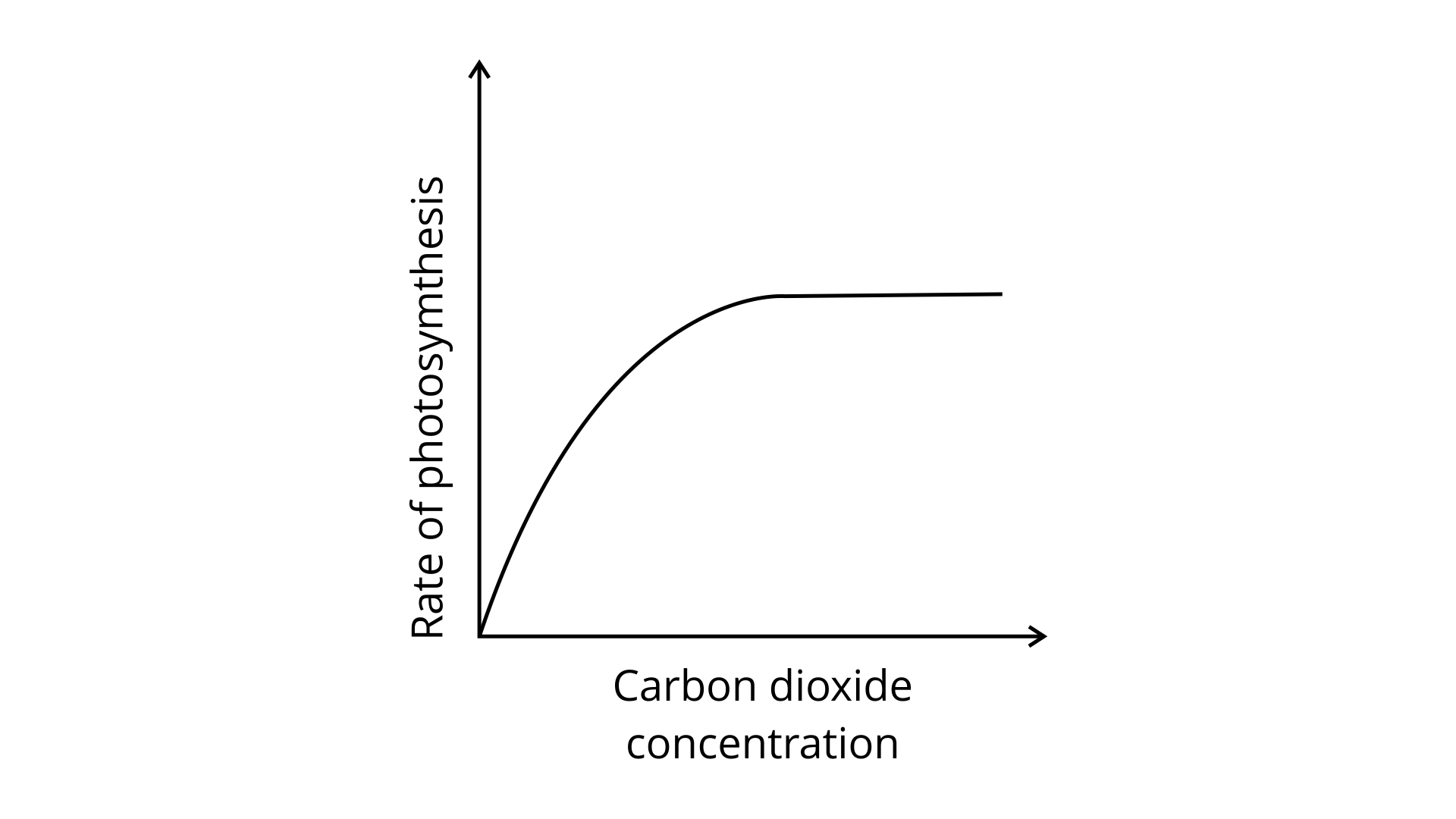
Progress check
1. Why is it necessary to destarch the leaves of a plant before performing an experiment on photosynthesis?
Ans: The leaves of plants are having starch in them. So, before we using a plant in the photosynthesis experiment, the initial starch present must be removed. This process is performed by keeping the plant in a completely dark room for at least three days.
2. Why do we perform an iodine test?
Ans: Iodine test is performed to test the presence of starch in leaves.The presence of starch can be indicated by blue-black colour as soon as we pour the iodine solution on the surface of the leaves.
3. What chemical do you use to remove carbon dioxide from inside a flask in certain experiments on photosynthesis?
Ans: Potassium hydroxide.
4. All food chain starts with a plant.Why is this so?
Ans: This is because plants are the producers , all the animals on the earth totally depend upon them for their nourishment in the direct or indirect manner.
5. The honey bee produces honey. In terms of the food chain , is the honey bee a producer or a consumer?
Ans: Honey bees are the consumer , this is because like the plants they can not prepare their own food rather they suck the nectar from the plants & then prepare the honey from it.
A. Multiple Choice Type-:
1. The production of starch, and not glucose, is often used as a measure of photosynthesis in leaves because
a) Starch is the immediate product of photosynthesis.
b) Glucose formed in photosynthesis soon gets converted into starch.
c) Starch is soluble in water.
d) Sugar cannot be tested.
Ans: Correct answer is (b) glucose formed in photosynthesis soon gets converted into starch.
2. The number of water molecules required in the chemical reactions to produce one molecule of glucose during photosynthesis is-:
a) Six
b) Twelve
c) Eighteen
d) Twentyfour
Ans: Correct answer is (a) Six. The chemical equation for photosynthesis is given below-:

3. The rate of photosynthesis is not affected by-:
a) light intensity
b) humidity
c) temperature
d) carbon dioxide concentration
Ans: Correct answer is(b) humidity.
4. Chlorophyll in a leaf is required for
a) breaking down water into hydrogen and oxygen
b) emitting green light
c) trapping light energy
d) storing starch in the leaves
Ans: Correct answer is (c) trapping light energy.
Photosynthesis is a process by which the autotrophic organisms(green plants) prepare their own food. It requires water, sunlight, chlorophyll & carbon dioxide. Chlorophyll is the photosynthetic pigment that traps the sun-light.
5. If the rate of respiration becomes more than the rate of photosynthesis, plants will:
a) continue to live, but will not be able to store food.
b) be killed instantly.
c) grow more vigorously because more energy will be available.
d) stop growing and die gradually of starvation.
Ans: Correct answer is (d) stop growing and die gradually of starvation.This is because due to access to the rate of respiration the plant is not able to store food and eventually it will die due to starvation.
6. Which one chemical reaction occurs during photosynthesis?
a) Carbon dioxide is reduced and water is oxidized.
b) Water is reduced and carbon dioxide is oxidized.
c) Both carbon dioxide and water are oxidized.
d) Both carbon dioxide and water are reduced.
Ans: Correct answer is (a) Carbon dioxide is reduced and water is oxidized.
Reduction is the process which involves the gain of the electrons while oxidation is the loss of electrons. Photosynthesis is the process by which plants prepare their own by using water , carbon dioxide , sunlight & chlorophyll. During this process carbon dioxide is converted into carbohydrates by the process of reduction & water gets oxidised.
7. The specific function of light energy in the process of photosynthesis is to:
a) reduce carbon dioxide
b) synthesize glucose
c) activate chlorophyll
d) split water molecule
Ans: Correct answer is (c) activate chlorophyll.
8. A plant is kept in a dark cupboard for about 48 hours before conducting any experiment on photosynthesis in order to
a) remove chlorophyll from the leaves.
b) remove starch from the leaves
c) ensure that no photosynthesis occurs.
d) ensure that the leaves are free from starch
Ans: Correct answer is (b) to remove starch from the leaves.
9. During photosynthesis the oxygen in glucose comes from-:
a) carbon dioxide
b) oxygen via air
c) water
d) both carbon dioxide and water
Ans: Correct answer is (a) carbon dioxide.
B. Very Short Answer Type
1. Name the following
a) The category of organisms that prepare their own food from basic raw materials.
Ans: Autotrophs , the example includes green plants & certain photosynthesizing bacteria.
b) The kind of plastids found in the mesophyll cells of the leaf.
Ans: Chlorophyll
c) The compound which stores energy in the cells.
Ans: The energy is stored in the form of ATP that stands for adenosine triphosphate.
d) The first form of food substance produced during photosynthesis.
Ans: The first form of food substance produced during photosynthesis is glucose that is later on can be stored in the form of starch in plants.
e) The source of carbon dioxide for aquatic plants.
Ans: The source of carbon dioxide for aquatic plants is respiration.
f) The part of chloroplast where the dark reaction of photosynthesis takes place.
Ans: The part of chloroplast where the dark reaction/ light independent reaction of photosynthesis takes place is stroma.
2. Given below are groups of terms. In each group the first pair indicates the relationship between the two terms.Complete the second pair accordingly.
(a) Chlorophyll : Magnesium : Haemoglobin : _______
Ans: Chlorophyll : Magnesium : Haemoglobin : Iron.
It is present in the ferrous form.
(b) Light reaction : Granum : Dark reaction : ________
Ans: Light reaction : Granum : Dark reaction : Stroma.
Photosynthesis is mainly divided into two phases. The dark reaction/ light independent reaction of photosynthesis takes place is stroma.
(c) Producers : Autotrophs : Consumers :_________
Ans: Producers : Autotrophs : Consumers : Heterotrophs.
Heterotrophs directly or indirectly depend upon producers for their nutritional requirements. The example includes humans.
(d) Respiration : Carbon dioxide : Photosynthesis : _______
Ans: Respiration : Carbon dioxide : Photosynthesis : Oxygen.
Photosynthesis is the process by which plants prepare their own by using water , carbon dioxide , sunlight & chlorophyll. During this process carbon dioxide is converted into carbohydrates by the process of reduction & oxygen is released as by product.
(e) Water & Minerals : Xylem :Prepared food : ________
Ans: Water & Minerals : Xylem :Prepared food : Phloem.
Xylem conducts water and minerals from roots to upper parts of the plant, while Phloem transports food prepared in the leaf to roots and other parts of the plant.
C. Short Answer Type-:
1. Identify the false statements and rewrite them correctly by changing the first or the last word only.
(a) Dark reactions of photosynthesis occur during night time.
Ans: This statement is false , dark reaction of photosynthesis are not dependent on light, hence the name is called dark reaction.
(b) Photosynthesis requires enzyme
Ans: This statement is true.
(c) Green plants are consumers.
Ans: This statement is false , green plants are producers.
(d) Photosynthesis results in loss of dry weight of the plants
Ans: This statement is false, photosynthesis results in an increase in weight of plants.
(e) Photosynthesis stops at temperature of about 35 degree celsius
Ans: This statement is false , photosynthesis stops at a temperature of about 40°C
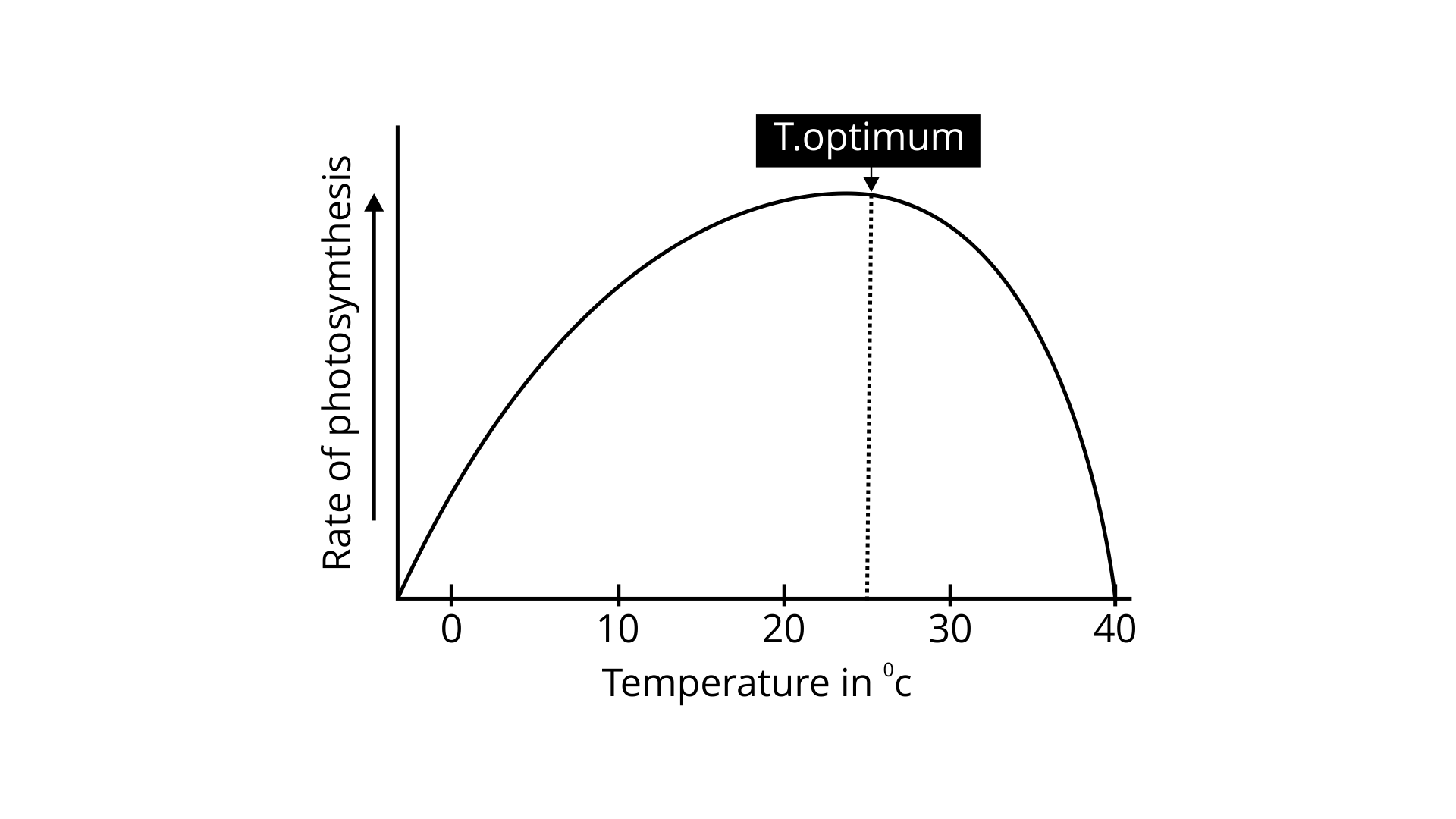
(f) Photosynthesis occurs only in cells containing chloroplasts
Ans: This statement is true.
(g) Green plants perform photosynthesis.
Ans: This statement is true.
(h) Algae are autotrophs.
Ans: This statement is true.
2. Fill in the blanks with the appropriate answer from the choices given in the brackets-:
(a) The site of light reaction in the cells of a leaf is………… (cytoplasm, stroma, grana).
Ans: The site of light reaction in the cells of a leaf is grana.
Photosynthesis is mainly divided into two phases.The light reaction of photosynthesis occurs in grana & the dark reaction/ light independent reaction of photosynthesis takes place is stroma.
(b) The chemical substance used to test the presence of starch in the cell of a leaf is.............. (calcium chloride, iodine solution, benedict solution).
Ans: The chemical substance used to test the presence of starch in the cell of a leaf is iodine solution.
The presence of starch can be indicated by blue-black colour as soon as we pour the iodine solution on the surface of the leaves.
(c) Stroma is the ground substance in......... (cytoplasm, chloroplast, ribosomes).
Ans: Stroma is the ground substance in chloroplast.
(d) The dark reaction of photosynthesis is known as…………. (Hill reaction, cyclic phosphorylation Calvin cycle).
Ans: The dark reaction of photosynthesis is known as Calvin cycle
(e) In the flowering plants food is transported in the form of…………. (Sucrose , Glucose , Starch).
Ans: In the flowering plants food is transported in the form of sucrose.The conducting tissue for the process of transportation of food in plants is phloem.
3. Are the following statements true or false? Give reason in support of your answer.
(a) The rate of photosynthesis continues to rise as long as the intensity of light rises.
Ans: This statement is false.
The rate of photosynthesis increases with the increase in light intensity but to a certain extent only and it gets stabilised, but too much of light intensity also destroys chlorophyll and reduces photosynthesis.
(b) The outside atmospheric temperature has no effect on the rate of photosynthesis.
Ans: This statement is false.
Temperature is one of the most important factor that affects the rate of photosynthesis. Everytime an increase in temperature of about 10 degree upto the optimum temperature (35°C) doubles the rate of photosynthesis.
c) If you immerse a leaf intact on the plant in ice cold water, it will continue to photosynthesize in bright sunshine.
Ans: This statement is false.
This is because photosynthesis is an enzyme dependent reaction which requires an optimum temperature. In an ice cold water, the low temperature does not favour the process of photosynthesis.
(d) Destarching of the leaves of a potted plant can occur only at night.
Ans: This statement is false.
One can perform it in the daytime too. All you need is darkness only so that plants are unable to perform the photosynthesis.
(e) If a plant is kept in bright light all the 24 hours for a few days the dark reaction (biosynthetic phase) will fail to occur.
Ans:
(f) Photosynthesis is considered as a process supporting all life on earth.
Ans: This statement is true.
All the animals on the earth depend upon the plants in the direct or the indirect manner for their nourishment. Herbivores depend directly on plants and the carnivores feeding on animals which depends on plants for their nourishment.
4. Given below are five terms. Rewrite the terms in the correct order so as to be in list sequence with regard to photosynthesis: (i) water molecules, (ii) oxygen, (iii) grana(iv) hydrogen and hydroxyl ions, (v) photons.
Ans: Photosynthesis is a process by which the autotrophic organisms(green plants) prepare their own food. It requires water, sunlight, chlorophyll & carbon dioxide.The process of photosynthesis is carried out in chloroplast.
The correct sequence with regard to photosynthesis is-:
Photons → Grana → Water molecules → Hydrogen & hydroxyl ions → Oxygen
5. State any four differences between photosynthesis and respiration.
Ans:
Photosynthesis | Respiration |
1. It is an anabolic process. | 1. It is a catabolic process. |
2.This process takes place only in the presence of sunlight. | 2.This process takes place both in the presence as well in the absence of sunlight. |
3. Oxygen is produced as a by-product. | 3. The main requirement for this process is oxygen. |
4. It takes place in green plants only. | 4. It takes place in all the living organisms. |
6. Complete the following food chains by writing the names or appropriate organisms in the blanks.
(a) Grass ………………….. Snake …………………………….
(b) …………… Mouse…………………… Peacock
Ans:
Food chain is defined as the sequence of transfer of matter and energy in the form of food from organism to organism.
(a) Grass → Grasshopper → Snake → Hawk
(b) Grass → Mouse → Snake → Peacock
7. How do non-green plants such as fungi and bacteria obtain their nourishment?
Ans: The non-green plants such as fungi and bacteria do not have chlorophyll. Therefore, they can't prepare their food themselves. They depend upon the others for their nourishment, thus called heterotrophs.
Bacteria and fungi get their nourishment from dead decaying organic matter.Hence , they are called saprophytes.
8. All life owes its existence to chlorophyll. Give a reason.
Ans: Chlorophyll is that molecule that absorbs sunlight and uses its energy to synthesise carbohydrates from carbon dioxide and water. This process is understood as photosynthesis, it is the basis for sustaining the life processes of all plants since animals and humans obtain their food supply by eating plants only.
9. Complete the following by filling in the blanks 1 to 5 with appropriate
words/terms/phrases:
To test the leaf for starch, the leaf is boiled in water to …………… (1). It is next boiled in methylated spirit to ……………………. (2) The leaf is placed in warm water to soften it. It is then placed in a dish and ……………………. (3) solution is added. The region, which contains starch, turns ……………. (4) and the region, which does not contain starch, turns ……………………(5)
Ans: To test the leaf for starch, the leaf is boiled in water to kill the cells (1). It is next boiled in methylated spirit to remove chlorophyll (2) The leaf is placed in warm water to soften it. It is then placed in a dish and iodine (3) solution is added. The region, which contains starch, turns blue black (4) and the region, which does not contain starch, turns brown (5)
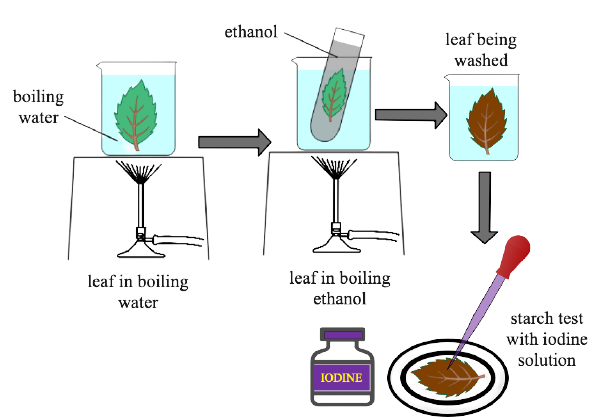
10. “Oxygen is a waste product of photosynthesis.” Comment.
Ans: Oxygen is evolved as a by-product of photosynthesis. Some part of it is utilized in the process of respiration, while a major part of it is diffused into the atmosphere. The aim of photosynthesis is to produce food only, not oxygen. Hence, it is considered as a waste product of photosynthesis. But in reality it is not a waste product because it is necessary for maintaining the life of all the living organisms on mother earth.
D. Descriptive type-:
1. Define the following terms:
a)Photosynthesis
Ans: Photosynthesis is a process by which the autotrophic organisms(green plants) prepare their own food. It requires water, sunlight, chlorophyll & carbon dioxide.The process of photosynthesis is carried out in chloroplast.
b) Thylakoids
Ans: It is defined as the membrane bound compartments inside the chloroplast that acts as the site of photochemical reactions that take place during the process of photosynthesis.
c) Chloroplast
Ans: It is the double membranous bound cell organelle that acts as the site of photosynthesis.
d) Photolysis of water
Ans: It is defined as the breakdown of water molecules in the presence of sunlight.It is mainly responsible for the liberation of oxygen during the process of photosynthesis.
e) Polymerization
Ans: It is defined as the process during which monomers join together to form a polymer. Starch is the polymer of glucose units.
2. Photosynthesis in green plants is directly and indirectly dependent on so many plant structures. Explain briefly the role of the following structures in this process.
a) Guard cells ………………..
Ans: Guard cells are located in the leaf epidermis. A pair of guard cells surround and form stomatal pores. Guard cells control the rates of diffusion of gases by controlling the size of the stomata.
b) Cuticle ……………….
Ans: It is the waxy layer that prevents the excess loss of water.
c) Mesophyll cells ……………………
Ans: Chloroplast are contained in the mesophyll cells found between the upper epidermis and lower epidermis.
d) Xylem tissue in the leaf veins ………………….
Ans: It is one of the important conducting tissues of the plant that is helpful in transport of water & minerals from the roots to all parts of the plant.
e) Phloem tissue in the leaf veins ……………………..
Ans: It is another conducting tissue of the plant that is responsible for transport of food from leaves to the other parts of the plant.
f) Stomata ……………………….
Ans: Stomata are the tiny pores present on the surface of leaves.Their main function is the exchange of gases.They allows the plant to take in carbon dioxide and give out oxygen for photosynthesis.
3. Give reason / Explain:
a) It is necessary to place a plant in the dark before starting an experiment on photosynthesis?
Ans: It is necessary to place a plant in the dark before starting an experiment on photosynthesis to destarch the plant so that the experiment provides accurate results.
b) It is not possible to demonstrate respiration in a green plant kept in sunlight
Ans: It is not possible to demonstrate respiration in a green plant kept in sunlight because during the day time green plants utilize the carbon dioxide in the process of photosynthesis.So there is no carbon dioxide liberation hence, no respiration demonstration.
c) Most leaves have the upper surface more green and shiny than the lower one.
Ans: In most of the cases, the upper surface of the leaf is in direct contact towards the sunlight. The photosynthetic pigment chlorophyll has a tendency to trap light energy for photosynthesis. Therefore, the upper surface of leaves appear shiny and more green due to more quantity of chlorophyll in the upper surface of the leaves.
d) During the starch test the leaf is -:
i) Boiled in water
Ans: To test the leaf for starch, the leaf is boiled in water to kill the cells.
ii) Boiled in methylated spirit
Ans: To remove the chlorophyll.
4. Distinguish the following pairs on the basis of words indicated in the bracts-:
a) Light reaction & dark reaction (end products)
Ans:
Light reaction | Dark reaction |
1. The end products of light reaction are oxygen , ATP & NADPH. | 1. The end product of dark reaction is glucose. |
b) Producers & consumers (organisms)
Ans:
Producers | Consumers |
1. The organisms that can prepare their own food are called producers. | 1. The living organisms that can not prepare their own food are called consumers. |
2.The example includes-: green plants. | 2.The example includes-:human beings. |
c) Grass & grasshopper (mode of nutrition)
Ans:
Grass | Grasshopper |
1. The mode of nutrition in grass is autotrophic due to the presence of photosynthetic pigment chlorophyll. | 1. The mode of nutrition in grasshoppers is heterotrophic ,they depend upon producers for their nourishment. |
d) Stoma & stroma (structure)
Ans:
Stoma | Stroma |
1. Stomata/Stoma are the tiny pores present on the surface of leaves, guarded by two guard cells that help in exchange of gases. | 1. It is the protein rich fluid that is present inside the chloroplast in which thylakoids are suspended. |
5. How would you demonstrate that green plants release oxygen when exposed to light?
Ans:
Aim-: To prove or demonstrate that green plants release oxygen when exposed to light.
Requirement-:Test tube, beaker, funnel, hydrilla plant etc.
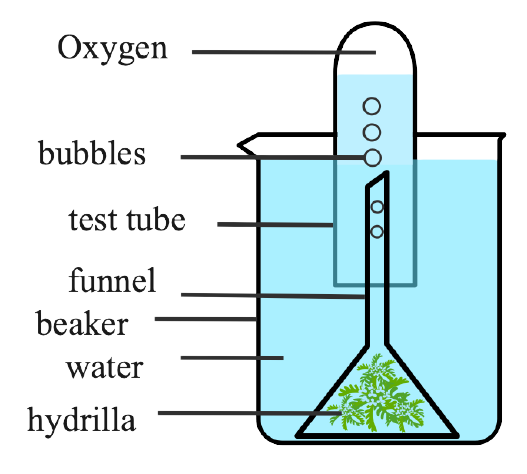
Procedure-:
1.Took some water plant like-hydrilla & place that in a beaker that contains pond water and cover them by a short stemmed funnel.
2.Invert a test-tube full of water over the stem of the fennel.
3.Place the apparatus in the sunlight for a few hours.
Observation-: Bubbles of the gas appear that can be collected in the test tube.
One can test the gas in the test tube by putting a glowing splint into it, which will burst into flame proving that green plants release oxygen when exposed to sunlight.
6. Describe the main chemical changes which occur during photosynthesis in: (i) Light reaction
Ans: It is the first phase of photosynthesis.The chemical changes that takes place during light reaction are-:
1.Activation of chlorophyll: Photons of light energy are trapped and activate the chlorophyll.
2. Photolysis of water-: The water splits in the presence of light energy to release into molecules of hydrogen, oxygen and the electrons. Hydrogen is used to reduce NADP and electrons are used in ATP production, while Oxygen is released as a byproduct.
a) Reduction of NADP-: The molecules of NADP are reduced to NADPH2 by H+ ions.
b) Formation of ATP-: ADP combines with inorganic phosphate in the presence of light & gives rise to ATP.
ADP + iP→ ATP
3. (ii) Dark reaction-: It is the second phase of photosynthesis. The chemical changes that takes place during dark reaction are-:
1. Function of CO2: The CO2 in the leaves combines with a five-carbon containing compound ribulose diphosphate and forms an unstable 6-carbon compound. This unstable compound splits into two molecules of 3-carbon containing compound phosphoglyceric acid (PGA). It is the first stable product that is formed during photosynthesis.
2. Formation of sugar. In the presence of ATP and NADPH2 the phosphoglyceric acid is converted into phosphoglyceraldehyde (PGAL) which is further converted into glucose.
3. Regeneration of RuDP. phosphoglyceric acid undergoes a series of reactions to produce ribulose 1,5-bisphosphate (RuBP).
The dark reaction is completed in multi-reactions. The series of all reactions during this phase is called the Calvin cycle.
E. Structured/Application/Skill Type-:
1.Given below is schematic diagram to illustrate some aspects of photosynthesis-:
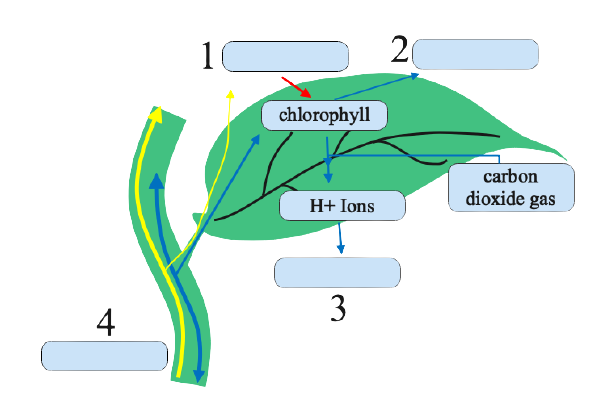
a) Fill up the gaps, in blank spaces (1-4), by writing the names of the correct items.
Ans:
Number | Name |
1 | Photon |
2 | NADP |
3 | NADPH2 |
4 | C6H12O6 |
b) What phenomena do the thick arrows A and B indicate respectively?
Ans: The arrows A & B indicate the polymerization.
It is defined as the process during which monomers join together to form a polymer.
2. Given below the representation of a certain phenomenon in nature, with four organisms 1-4-:

(a) Name the phenomenon represented
Ans: The phenomenon that is represented by the above diagram is the Food chain.
(b) Name any one organism that could be shown at No. 5
Ans: The organism that can be shown at no.5 is eagle.

(c) Name the biological process which was the starting point of the whole chain
Ans: The starting point of the whole food chain is photosynthesis.
(d) Name one natural element which all the organisms 2-4 and even 5 are getting from 1 for their survival.
Ans: Carbon in the form of carbohydrates.
3. A potted plant was taken in order to prove a factor necessary for photosynthesis. The potted plant was kept in the dark for 24 hours. One of the leaves was covered with black paper in the centre. The potted plant was then placed in sunlight for a few hours.Observe the diagram & answer the question

(a) What aspect of photosynthesis was being tested?
Ans: Sunlight or chlorophyll is necessary for photosynthesis.
(b) Why was the plant placed in the dark before beginning the experiment?
Ans: To destarch the plant.
(c) During the starch test why was the leaf
(1) boiled in water
Ans: To test the leaf for starch, the leaf is boiled in water to kill the cells.
(2) boiled in methylated spirit.
Ans: To remove the chlorophyll.
(d) Write a balanced chemical equation to represent the process of photosynthesis
Ans: The equation for photosynthesis is-:
6CO2 + 6H2O → C6H12O6 + 6O2
(e) Draw a neat diagram of a chloroplast and label its parts
Ans:
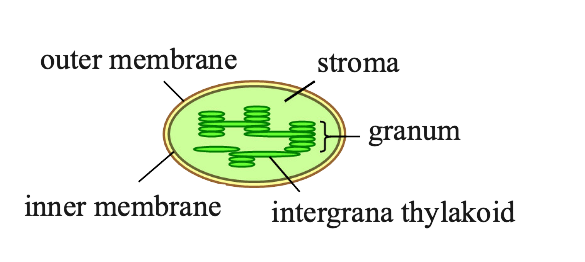
4. Given below is the diagram of an experimental set-up-:
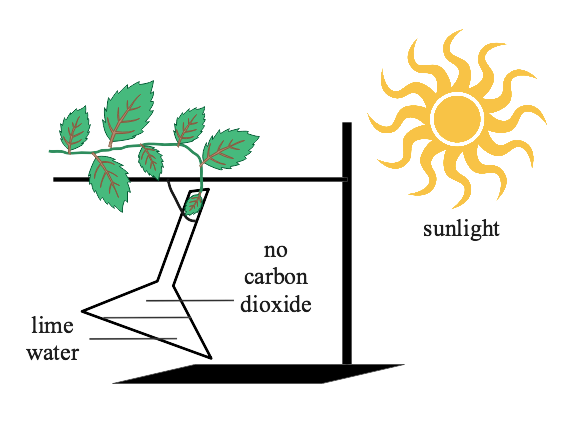
(a) What is the purpose of this experiment?
Ans: The objective of this experiment is to prove that carbon dioxide is necessary for photosynthesis.
(b) Will it work satisfactorily? Give reason
Ans: No, the experiment will not work satisfactorily because the beaker contains lime water which does not absorb carbon dioxide.
(c) What alteration(s) will you make in it to obtain the expected result?
Ans: One can use potassium hydroxide in order to obtain the expected results.
(d) Would you take any step before starting the experiment? Describe this step and explain its necessity.
Ans: Destarch the plant. One can perform this by keeping the plant in a completely dark room for at least three days.It is necessary to obtain the accurate results.
5. Draw a neat diagram of the stomatal apparatus found in the epidermis of leaves and label the Stoma, Guard cells, Chloroplast, Epidermal cells, Cell wall and Nucleus.
Ans:
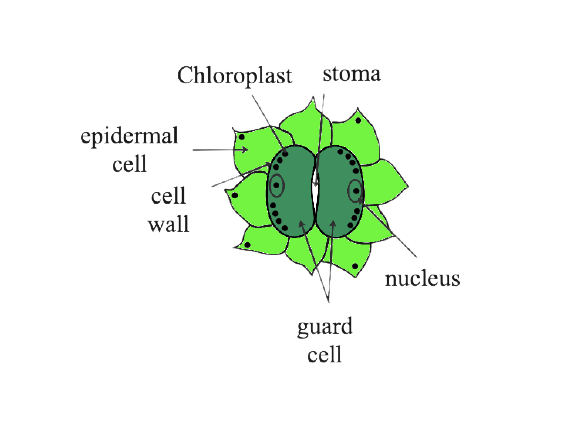
6. The diagram below shows two test-tubes A and B. Test-tube A contains a green water plant. Test-tube B contains both a green water plant and a snail. Both Test-tubes are kept in sunlight. Answer the questions that follow
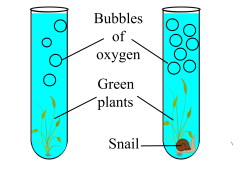
(a) Name the physiological process that releases the bubbles of oxygen.
Ans: Photosynthesis
(b) Explain the physiological process as mentioned above in Q.2 (a)(i).
Ans: Photosynthesis is a process by which the autotrophic organisms (green plants) prepare their own food. It requires water, sunlight, chlorophyll & carbon dioxide.The process of photosynthesis is carried out in chloroplast
(c) What is the purpose of keeping a snail in test-tube 'B'?
Ans: Carbon dioxide released by the snail during respiration is employed by the plant for photosynthesis. This increases the speed of photosynthesis within the plant placed in tube B. This also suggests that both respiration and photosynthesis are complementary processes to take care of the concentration of oxygen and carbon dioxide within the atmosphere.
(d) Why does test-tube 'B' have more bubbles of oxygen?
Ans: In test tube B, plant as well as snail is kept. The plant in tube B has more concentration of carbon dioxide available because the snail releases the carbon dioxide during the respiration that increases the speed of photosynthesis in the plant placed in test Tube B which leads to the release of more oxygen that appears in the form of bubbles.
(e) Given an example of a water plant that can be used in the above experiment.
Ans: Hydrilla verticillata
(f) Write the overall chemical equation for the above process
Ans: The equation for photosynthesis is-:
6CO2 + 6H2O → C6H12O6 + 6O2
Answer the following in simply “Yes” or “No”-:
1. Chlorophyll & chloroplast are the same thing.
Ans: No
This is because chloroplast is the double membrane bound cell organelle whereas chlorophyll is the photosynthetic pigment.
2. Oxygen given out in the photosynthesis comes from the atmosphere.
Ans: No ,Oxygen given out in the photosynthesis comes from the water.
3. Photosynthesis can also occur in artificial light such as that of a 100 watt electric bulb.
Ans: Yes
4. All the starch produced in a leaf remains stored in it for 2-3 weeks before it is used by the other parts of the plant.
Ans: No
Starch remains stored in the leaf for 2-3 days only.It is used by plants as soon as it stops the production of food by the process of photosynthesis.
5. Photosynthesis requires involvement of enzymes.
Ans: Yes
6. Plant requires several nutrients such as nitrogen, sulphur & iron.
Ans: Yes
7. Every green plant produces glucose as well as proteins & many other compounds.
Ans: Yes
8. All green plants are categorized as consumers.
Ans: No, this is because green plants can prepare their own food by the process of photosynthesis hence comes under the category of producers.
ICSE Class 10 Biology Chapter 6 - Photosynthesis Selina Solutions
Introduction
Selina Concise Biology Class 10 ICSE Solutions for Chapter 6 – Photosynthesis via Vedantu provides answers to all sorts of questions involved in chapter 6. With a deeper understanding of the knowledge, the Selina Concise Biology Class 10 ICSE Solutions for Chapter 6 – Photosynthesis makes sure students find it easier to understand the concepts involved by practicing the questions on their own.
Advantages of Selina Concise Biology Class 10 ICSE Solutions for Chapter 6 – Photosynthesis for Students of Class 10:
The advantages of using the Advantages of Selina Concise Biology Class 10 ICSE Solutions for Chapter 6 – Photosynthesis for students of Class 10 is one too many but here is a list of the advantages as to why students should consider using it:
1. Gives answers in a crisp format:
One of the main qualities of Selina Concise Biology Class 10 ICSE Solutions for Chapter 6 – Photosynthesis is that it provides crisp and clear answers that can be understood by reading just once or twice
2. Consists of questions for students to practice on their own:
With questions ranging from easy levels to higher difficulty levels, it makes the students run their brains and find answers to the questions on their own.
3. All the related topics are covered:
Apart from the main topic, all the related topics are also covered in the context of the Selina Concise Biology Class 10 ICSE Solutions for Chapter 6 – Photosynthesis for students of Class 10.
FAQs on Concise Biology Class 10 ICSE Solutions for Chapter 6 - Photosynthesis
1. What are the important topics covered in Selina Concise Biology Class 10 ICSE Solutions for Chapter 6 – Photosynthesis?
The variety of topics are covered in the Selina Concise Biology Class 10 ICSE Solutions for Chapter 6 – Photosynthesis via Vedantu and include the following:
concept of chlorophyll
concept of autotrophs who can make their own food
reactions involved in the process of photosynthesis
cells in plants and their roles
what are the products obtained
role of oxygen and carbon dioxide in photosynthesis
food chains and organisms involved
solutions to various experiments
All of these topics are covered in detail and in a very simple manner that students can easily access the topics.
2. What types of questions are involved in Selina Concise Biology Class 10 ICSE Solutions for Chapter 6 – Photosynthesis?
There are a variety of questions that are involved in the Selina Concise Biology Class 10 ICSE Solutions for Chapter 6 – Photosynthesis that helps teachers analyze the qualities of the students. The types of questions asked in the Selina Concise Biology Class 10 ICSE Solutions for Chapter 6 – Photosynthesis are as follows:
Multiple-choice questions that analyze the critical thinking skills of the students
Very short answer types that help students summarize the contents of the answer in one or two lines
Short answer type questions that include answers of about 3 to 4 lines each and must cover the topic in a bit detailed manner.
The descriptive type makes the answer of about 6 or more lines and involves explaining the topic quite briefly.
Structured or application or skill type questions which are added to assess how far has the concept been understood by the student.
3. What are the reference books that are a must-read for Biology Class 10 ICSE Chapter 6 – Photosynthesis?
There are a number of reference books that one can refer to apart from Selina Concise Biology Class 10 ICSE Solutions for Chapter 6 – Photosynthesis that will help students understand the concepts well and they include:
Guide-evergreen consists of nearly 25 specimen papers apart from other previous years' question papers.
MTG books that work wonders for biology subjects can also be used
NCERT books
All of these books can be added along with the Selina Concise Biology Class 10 ICSE Solutions for Chapter 6 – Photosynthesis which is more than sufficient for all the answers you are looking for. You can also use Vedantu’s live classes that provide a detailed review of each chapter.
4. According to Selina Concise Biology Class 10 ICSE Solutions for Chapter 6 – Photosynthesis what does photosynthesis mean?
According to Selina Concise Biology Class 10 ICSE Solutions for Chapter 6 – Photosynthesis via Vedantu, photosynthesis is one of the most significant life processes involved in the life of a plant. This process not only provides food to the plants themselves but also provides food to the humans along with the other organisms. This process is also responsible for one of the main sources of oxygen where the plants take in Carbon Dioxide and perform the process of photosynthesis to release oxygen to the atmosphere. Chapter 6- Photosynthesis allows the students to learn various aspects involved in this process and how it is influential on the daily life of other organisms.
5. Will Selina Concise Biology Class 10 ICSE Solutions for Chapter 6 – Photosynthesis help in the preparation of the SOF NSO exam?
For students of Class 10 looking to appear for the SOF NSO exam, it is important that they understand the concepts clearly mentioned in the syllabus. With the help of Selina Concise Biology Class, 10 ICSE Solutions for Chapter 6 – Photosynthesis via Vedantu students can access the topics without any difficulties and understand what the topic wants to convey. This chapter also is one of the main focuses of competitive exams and also for higher studies, is quite important as it affects the overall performance in the exam.





































